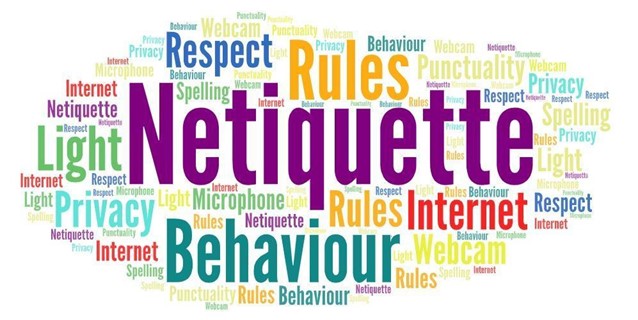Explore all MAP dissemination activities and materials. Stay tuned and follow us on all our social media channels!
Netiquette

Netiquette
You might have met the word “netiquette” before, but do you know its origin and meaning?
The term netiquette is a combination of “net” and “etiquette”. It refers to a code of good online behaviour.
In module 3 of our Train the Trainer Course you can find a paragraph focused on distance learning and teaching netiquette.
It is fundamental for you to know the core rules of netiquette before starting your online or blended teaching activity. Moreover, you should explain them to your students and make sure that they are aware of their importance. This will help you create an engaging and respectful learning environment.
The main rules concern place, punctuality, identification, use of the webcam, of the microphone and of the chat box, time to speak and, last but not least, privacy.
Let’s go through the most important netiquette rules to ripect when teaching (and learning) online:
- Place:
- Make sure that the place where you deliver or take your online classes has limited or no distractions.
- Make sure there is a good Internet connection.
- Be aware of your surroundings. You might want to remove personal items.
- Punctuality:
- Respect the schedule of others, be on time.
- Sign on around 10-15 minutes before the scheduled start time so you can solve any technical issues.
- Identification:
- Do not use nicknames, all participants must be able to easily recognise you.
- Name yourself with name and surname, it is helpful in case you share your first name with another participant.
- Use of the webcam:
- When possible, keep your webcam on, otherwise it may give the impression that you are not engaged or not paying attention.
- Make sure you look presentable, wear the same clothes you would wear if you were at school / training centre.
- Light your face and keep your head high in the picture frame, so that everybody can see you, avoid being backlit.
- Be on your best behaviour (avoid eating, drinking, checking emails or messages…). Having a glass of water or cup of tea is acceptable, but no slurping.
- Use of the microphone:
- Mute your microphone to allow everyone to listen to the speaker correctly and to avoid background noise.
- Only turn the microphone on when it is your time to speak. For short insertions, use the temporary unmute option.
- Use of the chat box:
- Think before you type: stay on topic, show respect, avoid inappropriate language and writing in capital letters, it means you are shouting.
- Do not overuse the chat box, use it only to ask questions if somebody else is speaking and when your contribution is relevant to the topic.
- Use proper spelling, grammar and punctuation: your messages must be easy to read and understand.
- Avoid chatting in the background with a co-learner. It is just as disrespectful as doing it in the classroom. You can chat after the session.
- Time to speak:
- Use the “Raise hand” function before speaking and wait for your name to be called.
- Everyone must have the chance to speak, do not monopolize the session.
- Privacy:
- If it is on the Internet, it is everywhere and what goes online, stays online forever… or at least for a long time. There is no real privacy online, so avoid anything considered inappropriate and handle what you share wisely.
- Treat others’ privacy the same way you would want yours to be treated. Do not share personal information of other people online.
- If you want to take a screenshot or record a session, remember to ask for permission.